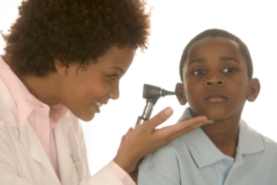Children Who Are Deaf or Hard of Hearing
Children who cannot hear well enough in order to make sense of what they are hearing are labeled as having a hearing impairment. Some of these children may not be able to hear at all. Others may be able to hear some sounds, but they are unable to make sense of what they hear because the sounds they hear are very low or distorted. In other words, they do not have functional hearing. Hearing is usually measured in decibels (see full Glossary), and it measures the child’s ability to hear low as well as high sounds. A hearing test is usually administered by an audiologist (Fig. 1).
Figure 1. Audiologist
Hearing loss can be classified in many ways:
- Bilateral versus unilateral: bilateral hearing loss means the child has hearing loss in both ears. Unilateral means the child has hearing loss in only one ear;
- Pre-lingual versus post-lingual: pre-lingual means the child has had trouble hearing either since birth, or after birth but before he or she started to talk. Post-lingual refers to children who have lost their hearing after they learned how to talk.
There are many levels of hearing loss (BC Ministry of Education):
- Minimal: hearing loss is between 16 and 25 decibels. The child is able to hear relatively well without a hearing aid, especially in quiet places. In loud or crowded places, the child may miss out on parts of conversation. A hearing aid may be used but not all the time;
- Mild: hearing loss is between 26 and 40 decibels. The child has some residual hearing but is usually not able to hear well and participate in discussions and conversations without a hearing aid. This is especially true if the child is in a loud setting, such as the classroom;
- Moderate: hearing loss is between 41 and 55 decibels. Hearing aids (or other amplification devices, please see below) are essential. The child may be able to hear bits and pieces of conversations, but it would be a struggle;
- Moderate to severe: hearing loss is between 56 and 70 decibels: the child is unable to hear anything and make sense of it without the help of a hearing aid;
- Severe: hearing loss is between 71 and 90 decibels. The hearing loss is quite serious and the child needs a hearing aid all the time;
- Profound: hearing loss of more than 91 decibels. The child is practically completely deaf and does not usually rely on his or her sense of hearing in order to obtain information from the environment.
There are also many types of hearing loss. To learn about these types, please visit the birth to six portion of this course.
Having a hearing loss could have a serious impact on almost all areas of development:
- Cognitive: some children with hearing loss may be less advanced than their typically developing peers. Most will eventually catch up. During the elementary school years, some children with hearing loss may have reading and writing skills that are behind those of their hearing peers. This is most likely the result of the child’s difficulty with language (please see below), as reading and writing are language-based tasks;
- Language and communication: many children with hearing loss have less than perfect language skills. The reason for this is obvious: one must hear language in order to develop it. Because they cannot hear language, or at least hear it well enough to make sense of it, many children who are deaf are quite late reaching language development milestones. They struggle with expressive and receptive language, as well as pragmatic language. Their articulation may not be perfect because they need to hear it in order to say it right;
- Social/emotional: some children who are deaf have low self-esteem. Some feel isolated at school because their peers often do not speak their language (American Sign Language). Some may experience difficulties with their social skills as well, as it is not always easy to function in a world that relies so much on oral language;
- Motor: some children who are deaf reach motor milestones later than their hearing peers. Most eventually catch up, and by school age many children who are deaf have motor skills that are comparable to those of their hearing peers.
Some children with hearing loss start their academic lives attending schools for the deaf. In these schools, they learn how to use American Sign Language (ASL) (Fig. 2), which becomes their primary language. In fact, children who are deaf and who speak ASL (which is the sign language system that is used in the United States and all of Canada except Quebec) are considered English Second Language (ESL). That is because their first language is ASL. ASL is a regular language, just like English, with its own rules of syntax and morphology. The grammatical rules of ASL are not similar to the rules of English. In fact, they are completely different. Sometime during the elementary school years, these children will eventually start attending regular schools with their hearing peers.
Figure 2. Sign language
Children who are deaf are perfectly capable of functioning well in a hearing world. But they do need help. They need help in order to understand others and in order for others to understand them. The most common devices available to children who are deaf are:
- Hearing aid: the hearing aid is an amplification device. It makes the sounds that are in the child’s environment louder. The child can adjust the loudness level of his or her hearing aid. Hearing aids used to be quite bulky. Some are now very small, fit inside the ear, and may not be noticed at all by those who do not know that the child is wearing a hearing aid. The trouble with some hearing aids is that they amplify ALL sounds, which sometimes makes it hard for a child who is wearing them to hear others well (because of interference). Hearing aids are the most commonly used hearing device by children and adults who are deaf (meaning they have no functional hearing) or hard of hearing (Fig. 3) (meaning they have some functional hearing);
Figure 3. Hearing aid
- FM system: the FM system is sometimes referred to as “Auditory Training Equipment.” It consists of two parts: the microphone that the teacher or anyone communicating with the child wears, and a receiver that the child wears in his or her ear. The teacher speaks into the microphone and the sound comes out of the receiver. The advantage of the FM system is that it brings the sound directly to the child, without the distraction of other sounds that may be in the classroom;
- Lip reading: many children who are deaf read lips. They are able to make sense of what others are telling them by listening to them (through any device they may be using) and by reading their lips. In the classroom, the teacher needs to make sure that he or she is always facing the child when communicating something to the classroom, otherwise the child who is deaf may miss out on what he or she is saying. Those communicating with a child who is a lip reader should always remember not to cover their mouths or over-enunciate, when speaking with the child;
- Sign language interpreter (Fig. 4): some children who are deaf may have a sign language interpreter with them in the classroom. The sign language interpreter will translate what the teacher and other children are saying to the child (that is, he or she will transform speech into sign) and will transform what the child who is deaf is signing, into speech, so the teacher and classmates can understand what the child is saying. If the child has a sign language interpreter, it is essential that those talking to the child look at him or her and not the interpreter during a conversation.
Figure 4. Sign Language Interpreter
For information about other available options for children who are deaf or hard of hearing, please visit the birth to six part of this course.
Children who are deaf could use help from the following professionals:
- Special educator with special training in hearing loss: the special educator will help the child who is deaf or hard of hearing with all matters related to academic development;
- Speech and language pathologist: the SLP will help the child who is deaf or hard of hearing learn how to use ASL, how to make the most of wha hearing they might have, and learn how to use language in social situations.
Children who are deaf or hard of hearing may reach developmental milestones later than their hearing peers. But most turn into completely well-adjusted and happy adults who participate fully in every aspect of typical life.




0 comments
Kick things off by filling out the form below.
Leave a Comment